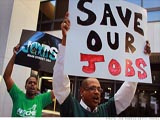Public Sector Job Cuts: The Human Cost Is Colossal
Post Views 0
According to a survey by the National League of Cities last year, 19 percent of US cities cut spending for public safety. The government’s thrust is more on ‘leaner and cheaper governments.’
City leaders in cash-strapped Camden, N.J, laid off more than 60 firefighters just over a year ago. Camden, a city of 77,000, also cut 168 police officer jobs in 2011. Similar stories of layoffs by various government departments add up to a huge loss of government jobs.
The per-capita employment rate in public education, which hired the most people in the government, is the lowest in more than a decade. According to a new survey by school administrators, “seventy-one percent of school districts reported cuts in state and local funding from last year’s budget, 68 percent eliminated positions this year, and 65 percent expect to do so again next year.”
Nicholas Johnson, vice president for state fiscal policy said, “When the recession hit, 33 states raised tax rates, but that wasn’t enough to make up for the decline in property, sales and income tax revenues, which still haven’t fully recovered. The recession caused 41 states to raise state college tuition and lay off university staff; 30 cut funding for local school districts; 25 cut funding for seniors and people with disabilities; and 30 states cut the availability of health care services.”
According to a new survey by the American Association of School Administrators, the percentage of teachers who feel their job is insecure has jumped from 8 percent in 2006 to 34 percent last year. Job satisfaction has dropped from 59 percent to 44 percent.
Teachers at the Chester Upland School District outside Philadelphia, where budget cuts forced layoffs of 187 of the district’s 320 teachers, are apprehensive that they may not get paid. “We have not missed a paycheck yet, but we don’t know from paycheck to paycheck if there’s going to be money there,” said Gloria Zoranski, president of the Chester Upland Education Association. “There’s money through the end of March,” but April is unclear.
A five percent cut in state funding, translated to a $29 million budget shortfall, forcing the Louisiana State University Health Care Division to cut 600 positions from its seven hospitals. Next year, the seven-hospital LSU system faces $20 million in additional cuts. Dr. Townsend said, “My employees haven’t had a raise in three years. And next fiscal year, we don’t plan on giving merit increases because there’s just no money to do that.”
Figures from the Office for Budget Responsibility (OBR) expose the enormity of the problem. OBR has warned that public sector job cuts will be even more harsh than originally forecast. It predicted an enormous increase in public sector job losses up to 2017; from 400,000 to 710,000. Even though OBR expects this rate to be less this year, it still means an average loss of 10,000 jobs a month up to 2017. The OBR is now “expecting that total public sector employment reductions will be as high as 730,000.”
Public Sector Job Cuts: The Human Cost Is Colossal by Harrison Barnes


 How to Feel If You Keep Losing Jobs
How to Feel If You Keep Losing Jobs  How to Explain Being Fired
How to Explain Being Fired  What to Do after a Layoff
What to Do after a Layoff  How to Cope With Losing a Job
How to Cope With Losing a Job  5 Steps to Take after Getting Laid Off
5 Steps to Take after Getting Laid Off  Top 10 Tips for How to Cope Financially After a Layoff
Top 10 Tips for How to Cope Financially After a Layoff  The Bright Side of Unemployment
The Bright Side of Unemployment